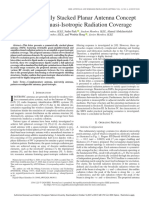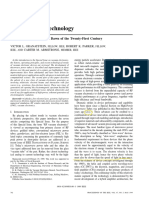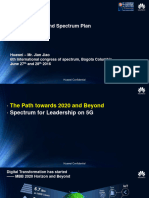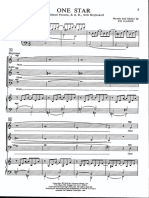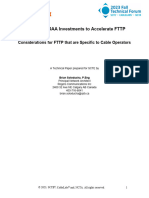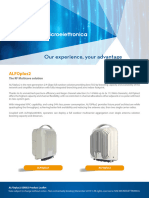08739891
08739891
Uploaded by
payam79bCopyright:
Available Formats
08739891
08739891
Uploaded by
payam79bCopyright
Available Formats
Share this document
Did you find this document useful?
Is this content inappropriate?
Copyright:
Available Formats
08739891
08739891
Uploaded by
payam79bCopyright:
Available Formats
Politechnika Warszawska
Warsaw University of Technology
http://repo.pw.edu.pl
A mm-Wave Beam-Steerable Leaky-Wave Antenna with Ferroelectric
Publikacja / Publication Substructure,
Nyzovets Denys, Yashchyshyn Yevhen
Adres publikacji w Repozytorium URL /
http://repo.pw.edu.pl/info/article/WUTb523170a169c4dbfa49d5ad00148f998/
Publication address in Repository
Data opublikowania w Repozytorium /
July 23, 2019
Deposited in Repository on
Identyfikator pliku / File identifier WUTcf592db04d8944c6a4b501c328626a6b
Identyfikator publikacji / Publication identifier WUTb523170a169c4dbfa49d5ad00148f998
Nyzovets Denys, Yashchyshyn Yevhen: A mm-Wave Beam-Steerable Leaky-
Wave Antenna with Ferroelectric Substructure, In: 2019 13th European
Cytuj tę wersję / Cite this version
Conference on Antennas and Propagation (EuCAP), 2019, Institute of
Electrical and Electronics Engineers, ISBN 9781538681275, pp. 1-4
13th European Conference on Antennas and Propagation (EuCAP 2019)
A mm-Wave Beam-Steerable Leaky-Wave Antenna
with Ferroelectric Substructure
Denys Nyzovets, Yevhen Yashchyshyn
Warsaw University of Technology
Institute of Radioelectronics and Multimedia Technology, Warsaw, Poland
D.Nyzovets@ire.pw.edu.pl, E.Jaszczyszyn@ire.pw.edu.pl
Abstract—In this paper, a novel mm-wave beam-steerable There are four main ways for beam steering that can be
antenna with ferroelectric substructure is presented. achieved by using:
Ferroelectric substructure is placed under grounded substrate • electronic devices (FET-switches, PIN-diodes, varactors
of antenna and coupled with it by three slots etched in internal diodes) [2];
metallic sheet. The radiation pattern control capability is
demonstrated by varying the permittivity of the ferroelectric • electro-mechanical devices (MEMS-switches) [3];
substructure. The proposed antenna is an excellent solution for • electro-optical devices (optically controlled
a low-cost mm-wave beam-forming due to high radiation semiconductor switches) [4];
efficiency, high gain, low-profile, and low cost of fabrication. • tunable materials (ferrites, liquid crystals, ferroelectric)
Index Terms—antennas, beam-steering, ferroelectric [5-9].
material, leaky-wave antennas, mm-wave. Electronic devices are most widely used for beam
steering. The beam direction of the antenna can also be
I. INTRODUCTION controlled by changing the properties of materials used as an
Pobrano z http://repo.pw.edu.pl / Downloaded from Repository of Warsaw University of Technology 2024-04-20
antenna substrate. Well known materials which are suitable
The key advantage of wireless systems operating in mm- for beam-steering are ferrites, liquid crystals and
wave frequencies is the large bandwidth available in this ferroelectrics. The properties of materials can be changed by
band. For example, W-band (75-110 GHz) can provide high- applying external magnetic (for ferrites) or electric (for
speed links with data throughput more than 10 Gbps. liquid crystal and ferroelectric) field.
The most important challenges for mm-wave The LWA based on the ferrite consists of ferrite filled
communication systems are to overcome free space path loss waveguide without a lateral metal wall or with slots made on
which is higher than in conventional low-frequency bands the side wall [5]. Under the magnetic field applied to the
and to provide adaptive and precise alignment of antenna ferrite their permeability is changed, which in turn effects the
beam. Typically, beam-steering in microwave frequency radiation direction of antenna.
band is achieved by means of phase-shifting or switching [1]. Liquid crystals (LCs) are perspective candidates for
However, such approach is not feasible in mm-wave range steerable LWA at high frequencies due to their controlled
due to absence of required components. permittivity and low losses. Liquid crystal is a nonlinear
To overcome difficulties of transmission in mm-wave material. Orientation of their molecules can be changed
range, high-gain and beam-steerable antennas at the under the influence of an external static electric field. Tuning
transmitting and the receiving side are required. According of dielectric permittivity allows to control the phase constant
to the general cost reduction trend, this paper describes a new and the radiation beam direction of the LWA [6]. LC
leaky-wave antenna (LWA) as low-cost alternative for mm- requires a low bias voltage for control, which simplifies the
wave array antennas and presents simulation results which control circuit. However, the complexity of integration in
have proved electronic steering capabilities. antenna structure and slow response limits application of LC
The main advantages of this antenna are: high gain, wide in antennas.
bandwidth and ability of electrical beam steering at fixed An example of steerable antenna based on a tunable
frequency. ferroelectric has published in [7]. It is built on a multilayered
substrate, which consists of a thin layer of ferroelectric,
II. STEERABLE LEAKY-WAVE ANTENNAS located between two conventional dielectric layers. Change
Conventional LWAs are not capable for beam scanning of the dielectric permittivity leads to the change of the total
at a fixed frequency. In order to overcome this issue, beam- dielectric permittivity of the whole multilayer substrate,
steerable LWAs have been introduced over the last decades. which in turn changes radiation pattern of the antenna.
In order to provide fixed-frequency scanning some active Antennas based on ferroelectric material have many
elements have to be integrate into the LWA structure. advantages in terms of continuous scanning, lightweightness
and compactness.
13th European Conference on Antennas and Propagation (EuCAP 2019)
III. NEW ANTENNA CONCEPT
The antenna, which has been presented in [8], uses
ferroelectric ceramic-polymer as a substrate. The antenna is
fed asymmetrically with quasi-TEM line. Wider microstrip
transmission line (acting on the first higher order mode)
operates as antenna. The biasing of the ferroelectric substrate
is achieved by using special DC-block. Fig. 1 shows this
electrically controllable scan antenna. Fig. 2. Cross-section of the scan antenna on ferroelectric substrate.
Thickness of the ferroelectric ceramic-polymer substrate
is ℎF=0.2 mm. Ferroelectric permittivity can be changed with
proper DC-bias. Fig. 2 shows the cross-section of this scan
antenna on ferroelectric substrate.
However, this antenna has some disadvantages. First of
all the DC biasing is applied to the antenna aperture directly.
It provides limitation because high voltage has to be used for
scanning. To avoid this disadvantage, we propose a new
concept of beam-steerable LWA.
Our new concept is also based on microstrip line in
which the first higher order mode is excited. Conventional
microwave substrate has been used instead of ferroelectric
substrate. For providing the control feasibility the Fig. 3. Configuration of the proposed LWA.
ferroelectric thin film has been added under bottom ground,
where slots are performed.
Proposed new concept in comparison with the previous
one eliminates DC-block, which isolates RF part from high
voltage DC bias and reduces level of DC voltage, because
Pobrano z http://repo.pw.edu.pl / Downloaded from Repository of Warsaw University of Technology 2024-04-20
thickness of ferroelectric film could be reduced to a few
micrometers. Fig. 3 illustrates the basic structure of the
antenna. The conventional substrate is a grounded LCP
substrate with relative permittivity of εr=3.78 and loss
tangent of tanδ=0.0045. LCP is an organic substrate with
excellent electrical properties in high frequency up to 110
GHz. LCP substrate is suitable for millimeter-wave
applications. On top of the LCP substrate the microstrip
LWA is formed. The antenna aperture length is L=7.14 mm
and width is W=0.76 mm (Fig. 4).
As mentioned previously, LCP substrate is stacked with
ferroelectric substructure, which thickness is ℎF=0.005 mm Fig. 4. The structure of the microstrip leaky-wave antenna.
and permittivity εt. The dielectric permittivity of the
ferroelectric εt can be changed by applying DC electric field
across the ferroelectric film. For this functionality the bottom
of the ferroelectric substructure is metalized in order to
enable the DC bias voltage (Fig. 5).
Fig. 5. Cross-section of the LWA with stacked substrates.
IV. SIMULATION RESULTS
The characteristics of the proposed LWA have been
Fig. 1. The structure of the scan antenna on ferroelectric substrate [8]. simulated using electromagnetic simulator FEKO. Fig. 6
13th European Conference on Antennas and Propagation (EuCAP 2019)
presents the parameter S11 for different values of ferroelectric Fig. 8 shows the antenna realized gain for different values of
permittivity from 8 to 23. These low values of ferroelectric the ferroelectric permittivity. The realized gain of the
permittivity can be obtained by using a ceramic-polymer antenna is greater than 6 dBi across the bandwidth of 90–95
composite [9]. Fig. 7 shows the ability of the beam-steering GHz.
by tuning the dielectric permittivity of the ferroelectric
substructure. V. CONCLUSION
A novel mm-wave beam-steerable antenna with
ferroelectric substructure has been presented. The proposed
antenna is an excellent solution for a low-cost mm-wave
beam-forming due to high radiation efficiency, high gain,
low-profile, and low cost of fabrication. The antenna
provides a realized gain higher than 6 dBi in the minimum 5
GHz bandwidth (e.g. from 90 to 95 GHz). The sector of the
scanning in the fixed frequency is around 7° (e.g. from 25° to
32° for 92 GHz).
The presented solution is quite innovative, promising and
seems to be easy to implement due to the use of technology
that has already been developed. This is especially true for
production of ferroelectric ceramic-polymers.
ACKNOWLEDGMENT
Fig. 6. Simulated S11 parameters for different values of the ferroelectric The work presented in this article was supported by
permittivity. H2020 ITN CELTA project under grant number 675683 of
Call: H2020-MSCA-ITN-2015.
Pobrano z http://repo.pw.edu.pl / Downloaded from Repository of Warsaw University of Technology 2024-04-20
REFERENCES
[1] Y. Yashchyshyn, K. Godziszewski, G. Bogdan, and P. Piasecki, “X-
band antenna array for low-cost beam scanning,” in IET Microwaves,
Antennas & Propagation, vol. 11, no. 15, pp. 2174-2178, 2017
[2] P. Bajurko, Y. Yashchyshyn, “Design and Investigation of the Leaky-
Wave Antenna with Reconfigurable Operating Frequency,” in: Proc.
European Conference on Antennas and Propagation EuCAP, 2009,
pp. 3753-3756
[3] T. Zvolensky, D. Chicherin, A. Räisänen, C. Simovski, M. Sterner, J.
Oberhammer, H. Hakojärvi, “Leaky-wave antenna at 77 GHz,” 41st
European Microwave Conference, European Microwave Week 2011,
Manchester, UK, October 10-14, 2011. Manchester, UK, 2011. p.
1039-1042 (European Microwave Conference).
Fig. 7. Normalised radiation pattern of the antenna for different values of [4] D. Patron, A. S. Daryoush, K. R. Dandekar, “Optical Control of
the ferroelectric permittivity (for 92 GHz). Reconfigurable Antennas and Application to a Novel Pattern-
Reconfigurable Planar Design,” Journal of Lightwave Technology,
vol. 32, no. 20, pp. 3394–3402, Oct. 2014.
[5] T. Kodera, C. Caloz, “Dual-Band Full-Space Scanning Leaky-Wave
Antenna Based on Ferrite-Loaded Open Waveguide,” IEEE Antennas
and Wireless Propagation Letters, vol. 8, pp. 1202–1205, 2009.
[6] M. Roig, M. Maasch, C. Damm, and R. Jakoby, “Electrically tunable
liquid crystal based composite right/left-handed leaky-wave antenna
at 26.7 GHz,” in 2014 44th European Microwave Conference, 2014.
[7] J. Modelski, Y. Yashchyshyn, “Voltage-controlled ferroelectric
microstrip antenna for phased arrays,” IEEE Antennas and
Propagation Society International Symposium, 2000, vol. 2, 2000, pp.
506-509 vol.2
[8] Y. Yashchyshyn, J. Modelski, “Rigorous analysis and investigations
of the scan antenna on ferroelectric substrate,” IEEE Transactions on
Microwave Theory and Techniques, vol. 53, issue 2, pp. 427-438,
February 2005
[9] Y. Yashchyshyn, J. Modelski, K. Godziszewski, P. Bajurko, E.
Pawlikowska, B. Bogdańska, E. Bobryk, M. Szafran, “Emerging
ferroelectric ceramic-polymer composites for sub-THz tunable
devices,” in Asia-Pacific Microwave Conference Proceedings
Fig. 8. Numerical estimation of the antenna gain for different values of (APMC), 2013, pp. 206–208.
the ferroelectric permittivity.
You might also like
- Asme B56.1Document88 pagesAsme B56.1Ana María FernándezNo ratings yet
- Quantum AntennasDocument33 pagesQuantum AntennasmuteflikaNo ratings yet
- Optical Antennas and PlasmonicsDocument18 pagesOptical Antennas and Plasmonics姚羽No ratings yet
- Electron Beam LithographyDocument11 pagesElectron Beam Lithographysagar paneliyaNo ratings yet
- Pai 2014-2Document11 pagesPai 2014-2Ehab WilsonNo ratings yet
- Substrate Integrated Transmission Lines: Review and ApplicationsDocument19 pagesSubstrate Integrated Transmission Lines: Review and ApplicationsFaiz JillaniNo ratings yet
- حسين مديح 2Document8 pagesحسين مديح 2MSc Ahmed AbdulredhaNo ratings yet
- Xianhao 2021 J. Phys. Conf. Ser. 1907 012042Document13 pagesXianhao 2021 J. Phys. Conf. Ser. 1907 012042ANGEL SHINY C PRK21EC2002No ratings yet
- SWNT Photovoltaic CellDocument12 pagesSWNT Photovoltaic CellsabitavabiNo ratings yet
- Understanding Electrical Treeing Phenomena in XLPEDocument8 pagesUnderstanding Electrical Treeing Phenomena in XLPEPrashant TrivediNo ratings yet
- TMP DEE5Document20 pagesTMP DEE5FrontiersNo ratings yet
- Propagation in Finite Lossy Media An Application To WBANDocument4 pagesPropagation in Finite Lossy Media An Application To WBANkumaravel.s2023No ratings yet
- Antennas Lecture 1 2024Document15 pagesAntennas Lecture 1 2024Athmajan VuNo ratings yet
- A Scalable Aperiodic RFIC Phased-Array Topology For The Mmwave SpectrumDocument2 pagesA Scalable Aperiodic RFIC Phased-Array Topology For The Mmwave SpectrumSteven YehNo ratings yet
- L06-10 - Optical DevicesDocument55 pagesL06-10 - Optical DevicesOmar FarukNo ratings yet
- Electric Field Analysis of Extra High Voltage (EHV) Underground Cables Using Finite Element MethodDocument5 pagesElectric Field Analysis of Extra High Voltage (EHV) Underground Cables Using Finite Element MethodFiras AryanNo ratings yet
- MOTL2014Document6 pagesMOTL2014Thảo Phạm QuangNo ratings yet
- 2022,Cao,用于甚低频机械天线的双频压电人工结构Document9 pages2022,Cao,用于甚低频机械天线的双频压电人工结构b294108971No ratings yet
- Design and Fabrication of 0/1-Level RF-Via Interconnect For RF-MEMS Packaging ApplicationsDocument7 pagesDesign and Fabrication of 0/1-Level RF-Via Interconnect For RF-MEMS Packaging Applicationsjulio perezNo ratings yet
- Adma 201001169Document5 pagesAdma 201001169Rana Sabouni TabariNo ratings yet
- Very-Low-Frequency Electromagnetic Field Detector With Data AcquisitionDocument12 pagesVery-Low-Frequency Electromagnetic Field Detector With Data AcquisitionAKMAL PUTRA HARYADINo ratings yet
- A Symmetrically Stacked Planar Antenna Concept Exhibiting Quasi-Isotropic Radiation CoverageDocument5 pagesA Symmetrically Stacked Planar Antenna Concept Exhibiting Quasi-Isotropic Radiation CoverageSYED IMRAN HUSSAINNo ratings yet
- Dual-Band Textile MIMO Antenna Based On Substrate Integrated Waveguide (SIW) TechnologyDocument8 pagesDual-Band Textile MIMO Antenna Based On Substrate Integrated Waveguide (SIW) TechnologySEBASTIAN MESA ZAFRANo ratings yet
- High Pulsed Power Sources For Broadband RadiationDocument11 pagesHigh Pulsed Power Sources For Broadband RadiationJayesh GanjiNo ratings yet
- AL-Haddad 2021 J. Phys. Conf. Ser. 1878 012068Document12 pagesAL-Haddad 2021 J. Phys. Conf. Ser. 1878 012068GurulakshmiNo ratings yet
- Wide Band EmpDocument7 pagesWide Band EmpAlphonso Winfield Ricardo Patrick-GrantNo ratings yet
- Biquad Anttena PaperfinalDocument9 pagesBiquad Anttena PaperfinalGabriel Henrique VieiraNo ratings yet
- Microwave Line of SightDocument10 pagesMicrowave Line of Sightndahemmy1No ratings yet
- These: SPIE Vol. 2191 /487Document7 pagesThese: SPIE Vol. 2191 /487Otras CosasNo ratings yet
- Antennas&Microwave Engineering: Lecture NotesDocument179 pagesAntennas&Microwave Engineering: Lecture NotesB38 PRERANA.M.CNo ratings yet
- Sar at Near DistanceDocument11 pagesSar at Near DistanceShashi KumarNo ratings yet
- Towards All-Optical Atom Chips Based On Optical Waveguides: December 2019Document26 pagesTowards All-Optical Atom Chips Based On Optical Waveguides: December 2019রানাদেNo ratings yet
- ProfZeng ICEAADocument6 pagesProfZeng ICEAAfougnygue_572575862No ratings yet
- Miniaturized Via-Free Magnetoelectric Dipole Antenna Fed by Substrate-Integrated Coaxial Line On Reactive Impedance SurfaceDocument11 pagesMiniaturized Via-Free Magnetoelectric Dipole Antenna Fed by Substrate-Integrated Coaxial Line On Reactive Impedance SurfaceSuman NelaturiNo ratings yet
- 2 - (1999) Vacuum Electronics at The Dawn of The Twenty-First CenturyDocument15 pages2 - (1999) Vacuum Electronics at The Dawn of The Twenty-First CenturyEnginNo ratings yet
- Applsci 12 00815 v2Document12 pagesApplsci 12 00815 v2hoopburnNo ratings yet
- Sci Rep 2011 Fs Laser Ionization DischargeDocument4 pagesSci Rep 2011 Fs Laser Ionization DischargeMartin MartinecNo ratings yet
- Mwoc ManualDocument66 pagesMwoc Manualrajasekhar annagariNo ratings yet
- Review Paper On Transmitarray AntennasDocument18 pagesReview Paper On Transmitarray AntennasWill RMNo ratings yet
- Guest Editorial Microwave Photonics: Microwave Photonics Can Be Defined As The Study of PhoDocument3 pagesGuest Editorial Microwave Photonics: Microwave Photonics Can Be Defined As The Study of PhoBhagyalaxmi BeheraNo ratings yet
- All-Optical NOT Gate Based On Nanoring Silver-Air Plasmonic WaveguideDocument4 pagesAll-Optical NOT Gate Based On Nanoring Silver-Air Plasmonic WaveguideSaif HassanNo ratings yet
- Compact Tapered Slot Antenna Array For 5G Millimeter-Wave Massive MIMO SystemsDocument6 pagesCompact Tapered Slot Antenna Array For 5G Millimeter-Wave Massive MIMO Systemssurendraloya99No ratings yet
- Design of Polyrod Antenna Having Iso Ux Radiation Characteristic For Satellite Communication SystemsDocument8 pagesDesign of Polyrod Antenna Having Iso Ux Radiation Characteristic For Satellite Communication Systemshung kungNo ratings yet
- Improved Models For Plasmonic Waveguide Splitters and Demultiplexers at The Telecommunication WavelengthsDocument6 pagesImproved Models For Plasmonic Waveguide Splitters and Demultiplexers at The Telecommunication WavelengthsRami WahshehNo ratings yet
- Blue ScreenDocument6 pagesBlue ScreenDiksha ThakurNo ratings yet
- Advance and Innovation in Wireless Power Transmission Technology For Autonomous SystemsDocument46 pagesAdvance and Innovation in Wireless Power Transmission Technology For Autonomous SystemsHNo ratings yet
- Kural 2011 J. Phys.: Conf. Ser. 305 012088Document11 pagesKural 2011 J. Phys.: Conf. Ser. 305 012088AdyNo ratings yet
- Abdulhussein 2021 J. Phys. Conf. Ser. 2114 012051Document8 pagesAbdulhussein 2021 J. Phys. Conf. Ser. 2114 012051yeyegak481No ratings yet
- 2023 Nanoscale Direct-Write Fabrication ofDocument9 pages2023 Nanoscale Direct-Write Fabrication ofMelvin LimNo ratings yet
- Microwave Photonics PDFDocument22 pagesMicrowave Photonics PDFAnonymous abnEBtW100% (1)
- Nano-Scale Mechanics of Nanotubes Nanowires and NanobeltsDocument5 pagesNano-Scale Mechanics of Nanotubes Nanowires and NanobeltsMarcos GentilNo ratings yet
- Abstract Template Seminatec Renan FB (1626)Document3 pagesAbstract Template Seminatec Renan FB (1626)Renan Daniel DomingosNo ratings yet
- Lecture Notes: M. TulasiramDocument134 pagesLecture Notes: M. Tulasiramzoom09529No ratings yet
- Ultra 11Document8 pagesUltra 11Raj RajNo ratings yet
- Advancements and Challanges in WPT - A Comprehensive ReviewDocument26 pagesAdvancements and Challanges in WPT - A Comprehensive ReviewMauricio Duarte AlmeidaNo ratings yet
- Icolim 2017 07964144 PDFDocument5 pagesIcolim 2017 07964144 PDFmateescu elenaNo ratings yet
- Micromachines 13 00864Document9 pagesMicromachines 13 00864SpencerNo ratings yet
- Optical Fibre Current Sensor For Electrical Power EngineeringDocument6 pagesOptical Fibre Current Sensor For Electrical Power EngineeringsulienNo ratings yet
- Reconfigurable Diffractive Antenna Based On Switchable Electrically Induced TransparencyDocument12 pagesReconfigurable Diffractive Antenna Based On Switchable Electrically Induced TransparencyAnuj SharmaNo ratings yet
- Design of Rectangular Microstrip Patch Antenna: March 2016Document7 pagesDesign of Rectangular Microstrip Patch Antenna: March 2016Fadi AlsaoorNo ratings yet
- Laser Metrology in Fluid Mechanics: Granulometry, Temperature and Concentration MeasurementsFrom EverandLaser Metrology in Fluid Mechanics: Granulometry, Temperature and Concentration MeasurementsNo ratings yet
- Dokumen - Tips - Alfoplus80 Ags Ags HPDF Idu Odu Cable Idu 80ghz l1 l2 Porta Fpga OutdoorDocument117 pagesDokumen - Tips - Alfoplus80 Ags Ags HPDF Idu Odu Cable Idu 80ghz l1 l2 Porta Fpga Outdoorpayam79bNo ratings yet
- EMC Test Report For: DOT 2256 B48B41B25B66 (KRY 901 537/1) and DOT 2266 B48B41B25B66 (KRY 901 537/2)Document98 pagesEMC Test Report For: DOT 2256 B48B41B25B66 (KRY 901 537/1) and DOT 2266 B48B41B25B66 (KRY 901 537/2)payam79bNo ratings yet
- Admv 2239Document2 pagesAdmv 2239payam79bNo ratings yet
- Installation Manual 2206140Document81 pagesInstallation Manual 2206140payam79bNo ratings yet
- Adar 5001Document9 pagesAdar 5001payam79bNo ratings yet
- 2 Huawei-Jian JiaoDocument24 pages2 Huawei-Jian Jiaopayam79bNo ratings yet
- ADSY1100 4 TX 4 RX, 0.1 GHZ To 20 GHZ Apollo MxFE 3UVPX Tuner + Digitizer + ProcessorDocument9 pagesADSY1100 4 TX 4 RX, 0.1 GHZ To 20 GHZ Apollo MxFE 3UVPX Tuner + Digitizer + Processorpayam79bNo ratings yet
- HMC 445Document6 pagesHMC 445payam79bNo ratings yet
- NASPO 2021 Ceragon Price ListDocument115 pagesNASPO 2021 Ceragon Price Listpayam79bNo ratings yet
- WF03Document103 pagesWF03payam79bNo ratings yet
- WM02 Millimeter Wave Electronics For High Capacity Wireless Networks Workshop SlidesDocument110 pagesWM02 Millimeter Wave Electronics For High Capacity Wireless Networks Workshop Slidespayam79bNo ratings yet
- Systems and Methods of Clock Synchronization Between Devices On A NetworkDocument46 pagesSystems and Methods of Clock Synchronization Between Devices On A Networkpayam79bNo ratings yet
- HMC 310Document6 pagesHMC 310payam79bNo ratings yet
- Attachment 0Document114 pagesAttachment 0payam79bNo ratings yet
- Peak Data RateDocument8 pagesPeak Data Ratepayam79bNo ratings yet
- Influence of White LO NoiseDocument11 pagesInfluence of White LO Noisepayam79bNo ratings yet
- HMC 604Document10 pagesHMC 604payam79bNo ratings yet
- Hinsha hmc317Document2 pagesHinsha hmc317payam79bNo ratings yet
- A Data-Rate Adaptable Modem SolutionDocument6 pagesA Data-Rate Adaptable Modem Solutionpayam79bNo ratings yet
- HMC 607 ChipsDocument6 pagesHMC 607 Chipspayam79bNo ratings yet
- Pe 188 X00 RegmapDocument433 pagesPe 188 X00 Regmappayam79bNo ratings yet
- HMC 603 Qs 16Document6 pagesHMC 603 Qs 16payam79bNo ratings yet
- 3618 Soloducha 5269 PaperDocument28 pages3618 Soloducha 5269 Paperpayam79bNo ratings yet
- HMC 580 ST 89Document6 pagesHMC 580 ST 89payam79bNo ratings yet
- HMC 577Document6 pagesHMC 577payam79bNo ratings yet
- HMC 602Document8 pagesHMC 602payam79bNo ratings yet
- HMC 576 ChipsDocument6 pagesHMC 576 Chipspayam79bNo ratings yet
- HMC 579Document6 pagesHMC 579payam79bNo ratings yet
- HMC 699Document12 pagesHMC 699payam79bNo ratings yet
- SIAE ALFOplus2 DatasheetDocument4 pagesSIAE ALFOplus2 Datasheetpayam79bNo ratings yet
- Nikola Tesla A Giant Eye To See Round The WorldDocument4 pagesNikola Tesla A Giant Eye To See Round The WorldBranko StankovićNo ratings yet
- DocumentDocument5 pagesDocumentYohannes Tibebu67% (3)
- 6202 RusDocument14 pages6202 Rus0310No ratings yet
- Cooking Vocab and Cooking VlogDocument2 pagesCooking Vocab and Cooking VlogMarwa DeebNo ratings yet
- Text Books: Book No. Title Author (S) Edition Text Books: Book No. Title Author (S) Edition Text Books: Book No. Title Author (S) EditionDocument25 pagesText Books: Book No. Title Author (S) Edition Text Books: Book No. Title Author (S) Edition Text Books: Book No. Title Author (S) EditionM HASIN ISHMAM JEETNo ratings yet
- Blyth Inserts A4Document16 pagesBlyth Inserts A4albano pereiraNo ratings yet
- 2006 Fishman PDFDocument8 pages2006 Fishman PDFPAYAMNo ratings yet
- Thickness of Rockwool InsulationDocument21 pagesThickness of Rockwool InsulationjrfmlNo ratings yet
- A Meeting of The Minds (Report) PDFDocument75 pagesA Meeting of The Minds (Report) PDFArif KhanNo ratings yet
- Cad Group ProjectDocument25 pagesCad Group Projectapi-352243139No ratings yet
- Nobel Biocare Implant CatalogDocument67 pagesNobel Biocare Implant Catalogk4ssdcNo ratings yet
- GE - Bently Nevada 3300 - 55 Dual Velocity Monitor DatasheetDocument11 pagesGE - Bently Nevada 3300 - 55 Dual Velocity Monitor Datasheetalvaro reisNo ratings yet
- PIP PCCA01D-2004 Data Sheet For Combustible and Toxic Gas MonitorsDocument4 pagesPIP PCCA01D-2004 Data Sheet For Combustible and Toxic Gas Monitors刘旭No ratings yet
- Songs Finger Plays and More : Alice The Camel Going To The ZooDocument2 pagesSongs Finger Plays and More : Alice The Camel Going To The ZooZah SchlafmützeNo ratings yet
- 12 Days of Boxing Science ChristmasDocument13 pages12 Days of Boxing Science ChristmasGaboxiNo ratings yet
- Mphephu Frederick 2Document44 pagesMphephu Frederick 2محمد محمودNo ratings yet
- SPL Led 960b User ManualDocument7 pagesSPL Led 960b User ManualElectric GuardNo ratings yet
- Jalani JaljeeraDocument14 pagesJalani JaljeeraChanchalsutharNo ratings yet
- Types of Logistic CharacteristicDocument1 pageTypes of Logistic CharacteristicMuhd AminNo ratings yet
- Coupling Failures in VFD Motor Fan: Torsional VibrationDocument15 pagesCoupling Failures in VFD Motor Fan: Torsional VibrationCairo Oil Refining Co.100% (1)
- Calculus 1 Table of ContentsDocument5 pagesCalculus 1 Table of ContentsMuhammad AkramNo ratings yet
- Chapter 39 - Fluid, Electrolyte, and Acid-Base BalanceDocument41 pagesChapter 39 - Fluid, Electrolyte, and Acid-Base BalanceMary Singleton100% (1)
- Dipole Moment presentationSIKANDAR-1Document13 pagesDipole Moment presentationSIKANDAR-1DevNo ratings yet
- Nissan Navara Rear Axle Removing InstructionDocument20 pagesNissan Navara Rear Axle Removing InstructionFkhrulaimnNo ratings yet
- ISVSej 10.7.27 ArpitaDocument15 pagesISVSej 10.7.27 ArpitaShreeya SNo ratings yet
- Binary Search Tree: Search Operation Insertion Operation Deletion OperationDocument12 pagesBinary Search Tree: Search Operation Insertion Operation Deletion OperationsupriyaNo ratings yet
- WRAP Food Grade HDPE Recycling Process: Commercial Feasibility StudyDocument45 pagesWRAP Food Grade HDPE Recycling Process: Commercial Feasibility StudyHACHALU FAYENo ratings yet
- Incarnate - The Last of The Lacers PDFDocument43 pagesIncarnate - The Last of The Lacers PDFSavNo ratings yet
- Correction To ISO Reference Ambient Conditions Plate 70624-40DDocument1 pageCorrection To ISO Reference Ambient Conditions Plate 70624-40DMax MaksNo ratings yet





















